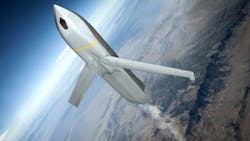Lockheed Martin to integrate M-Code anti-jam security into JASSM, JASSM-ER, and LRASM missile GPS guidance
EGLIN AIR FORCE BASE, Fla. – Guided missile experts at Lockheed Martin Corp. will integrate and support new secure satellite navigation technology into several kinds of land-attack and anti-ship missiles under terms of a $32 million contract announced last month.
Officials of the U.S. Air Force Life Cycle Management Center at Eglin Air Force Base, Fla., are asking the Lockheed Martin Missiles and Fire Control segment in Orlando, Fla., to integrate M-Code capability into the Joint Air to Surface Standoff Missile (JASSM), and provide support for M-Code integration into the JASSM Extended Range, the Long-Range Anti-Ship Missile (LRASM), and any other JASSM variant.
M-Code, a new military Global Positioning System (GPS) signal used in the 1575.42 MHz and 1227.60 MHz bands, is designed to improve security and anti-jamming properties of military navigation systems that use GPS guidance.
M-Code signals can be steered to specific regions using spot beam transmissions from GPS Block III satellites; the transmitted signals are expected to be around 20 decibels more powerful than the conventional full-Earth coverage beam.
M-Code also provides the U.S. military to with location information about friendly forces. Its signals are encrypted and their receivers are able to detect and reject false signals.
The JASSM-ER is a 2,250-pound cruise missile with a 1,000-pound penetrator and blast-fragmentation warhead. It uses precision routing and guidance in adverse weather, day or night, using an infrared seeker in addition to the anti-jam GPS to find a specific aim point on the target.
JASSM, which has been in service since 2009, is a long-range, conventional, air-to-ground, precision standoff missile for the U.S. and allied forces that is designed to destroy high-value, well-defended, fixed and relocatable targets. The JASSM has a range of 230 miles, while the JASSM-ER has a range of 620 miles.
The stealthy JASSM missiles have standoff ranges to keep air crews well out of danger from hostile air defense systems, while their stealthy airframes makes the smart munitions extremely difficult to defeat, Lockheed Martin officials say.
Related: Air Force accelerates program to provide M-Code GPS receivers to warfighters worldwide
JASSM can be fired from several different aircraft, including the B-1, B-2, B-52, F-16, F/A-18E/F, and F-15E. International JASSM users include the Australian, Finnish, and Polish air forces.
Looking to the future, Lockheed Martin is working on the JASSM to enable the missile to fire from U.S. and international versions of the Lockheed Martin F-35 Lightning II joint strike fighter aircraft and other international military aircraft.
LRASM, which is based on the Lockheed Martin JASSM-ER, is designed to detect and destroy high-priority targets within groups of ships from extended ranges in electronic warfare jamming environments.
On this order Lockheed Martin will do the work in Orlando, Fla., and should be finished by July 2025. For more information contact Lockheed Martin Missiles and Fire Control online at www.lockheedmartin.com, or the Air Force Life Cycle Management Center at www.aflcmc.af.mil.
About the Author
John Keller
Editor-in-Chief
John Keller is the Editor-in-Chief, Military & Aerospace Electronics Magazine--provides extensive coverage and analysis of enabling electronics and optoelectronic technologies in military, space and commercial aviation applications. John has been a member of the Military & Aerospace Electronics staff since 1989 and chief editor since 1995.
